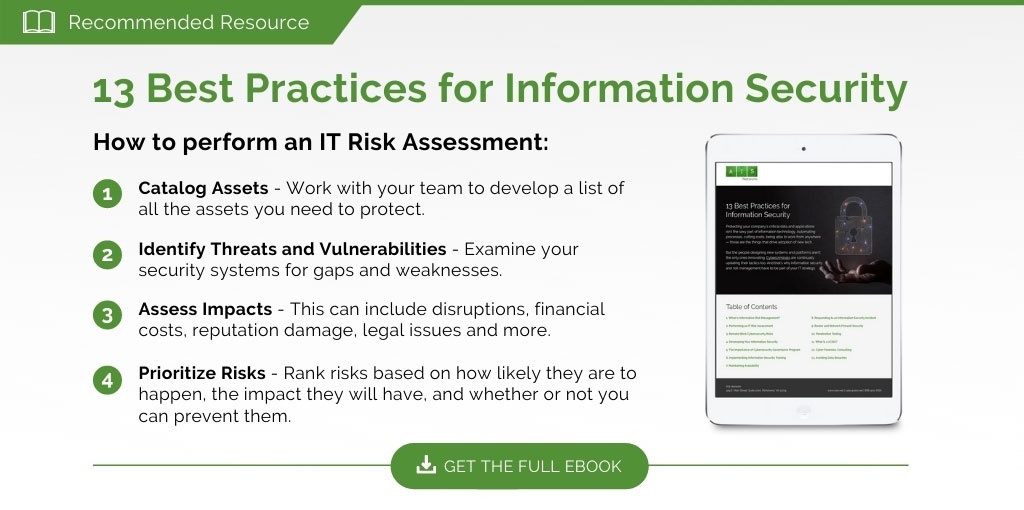How to Perform an IT Risk Assessment
Data and IT infrastructure threats are ever-evolving, and regular IT risk assessments are critical to protecting your organization. From the first computer worm in 1971 to the denial-of-service attacks and trojan viruses of the 1980s to modern ransomware and the current reality of large teams working remotely, cybersecurity risks have increased in frequency and impact. It would be best if you were prepared.
Companies of all sizes should incorporate risk assessments into their information security programs. Don’t make the mistake of thinking your business is too big to be damaged or too small to be vulnerable. Cybersecurity incidents regularly affect organizations of all sizes. Performing scheduled IT risk assessments following a documented internal audit procedure can help you evolve your responses to match threats and ensure compliance with industry and government standards and regulations.
Compliance Does Not Equal Security
Of course, compliance doesn’t guarantee information security. Especially during the current pandemic, which has forced many organizations to adapt operations for remote working, it’s best to take a proactive approach to security. That way, you can stay ahead of the game rather than respond to known threats.
But what does an IT risk assessment look like? The prospect can be daunting if you don’t have internal audit procedures focusing on security.
This post will outline the main steps to include in your cybersecurity strategy.
The first step in protecting your organization is establishing what risks you face and how they could affect your business. Establishing internal audit procedures can help you manage your risk and reduce — or even eliminate — the potential impact of cybersecurity incidents.
4 Steps to Perform an IT Risk Assessment
1. Identify Assets
The first step in conducting an IT risk assessment is identifying your assets. Knowing what you must protect makes it easier to determine which threats you must be ready for. Start with a simple list of your known assets and expand it with the help of your team.
- Physical infrastructure
- Operational systems
- Data (both internal and external)
- Clients
- Inventory
- Brand reputation
Prioritize assets that are important to your operations. All your assets are essential, but what can you least afford to lose? For example, your physical infrastructure and operational systems may be replaceable (especially if you have a disaster recovery strategy), but if they are out of commission, how much will it set you back financially? Data is valuable (and should be backed up regularly), but would compromised data set you back temporarily or open you up to legal action?

2. Identify Threats and Vulnerabilities
Once you know what’s at stake, start making a list of potential threats and vulnerabilities. Threats can encompass various events or incidents, including natural disasters, deliberate attacks, or remote employees accessing systems improperly.
Vulnerabilities are any gaps in your security that leave you open to harm from external threats. Penetration testing can help identify previously undetected holes in your defenses.
Be sure to include people from all levels of your organization in this stage of your IT risk assessment. Shipping staff will identify different assets and potential threats than human resources — and both may have great ideas for solutions.
3. Assess Impacts
Not all threats are equal. The possibility that a team member working from home might store project information somewhere insecure doesn’t necessarily carry the same risk as online criminals accessing your clients’ data and holding your systems for ransom.
Consider the following when assessing the potential impact of each threat or vulnerability:
- Disruption to daily operations (54% of businesses say this is the most significant impact)
- Financial losses (the average cyberattack costs victims over $1 million)
- Reputational damage (43% of companies suffer brand damage after an incident)
- The threat to your clients, partners, or staff
4. Prioritize Risks
Once you’ve identified your threats and vulnerabilities, you can begin prioritizing. Ask yourself which assets would have the most significant impact on your business if compromised, and rank threats to those assets based on the following:
- Likelihood of occurrence
- Impact on operations
- Your ability to anticipate and prevent them
Be sure to consider any unusual circumstances. For example, if all or part of your team is working from home, the risks you face will be different than if everyone is in a shared office.
Depending on your needs, this might be a great time to consider adding a Chief Information Security Officer (CISO) to your team, even part-time.
Need Help With Your IT Risk Assessment?
Conducting an IT risk assessment is not a one-and-done process. Monitoring new and evolving risks is crucial to adapting to and staying on top of threats and vulnerabilities. If you’re feeling overwhelmed by the prospect, the experts at AISN are always available to provide additional information and support to help protect your organization. Contact us today.


